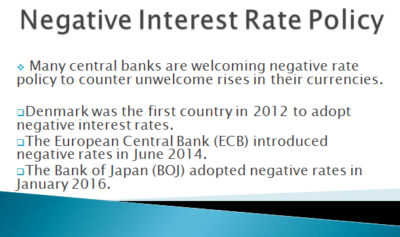How does Negative rate policy work? Diligent IAS 20/08/2019 – Posted in: Daily News
NEGATIVE RATE POLICY
For: Mains
Topics covered:
- What is Negative Rate Policy?
- Why are some central banks adopting?
- How does negative rate policy work?
- What are Pros and Cons associated with it?
- What are the central banks doing to mitigate the side effects?
News Flash
Negative rate policy is becoming a more attractive option for some central banks to counter unwelcome rises in their currencies.
It was once considered only for economies with chronically low inflation, such as Europe and Japan.
Current scenario
In Asia, central banks in economies as diverse as Australia, India and Thailand have stunned markets by cutting rates aggressively in response to the broadening fallout from the U.S.-China trade war.
Why have some central banks adopted negative rates?
- After the collapse of Lehman Brothers in 2008, many central banks cut interest rates near zero. A few years later, interest rates remain low in most countries due to subdued economic growth.
- With little space to cut rates further, some major central banks have resorted to unconventional policy measures, including a negative rate policy.
- The euro area, Denmark, Sweden, Switzerland and Japan have allowed rates to fall slightly below zero.
How does negative rate policy work?
- Under a negative rate policy, financial institutions are required to pay interest for parking excess reserves with the central bank.
- That way, central banks penalise financial institutions for holding on to cash in the hope of prompting them to boost lending.
Pros
They help weaken a country’s currency rate by making it a less attractive investment than that of other currencies. A weaker currency gives a country’s export a competitive advantage and boosts inflation by pushing up import costs.
Cons
- Negative rates put downward pressure on the entire yield curve and narrow the margin financial institutions earn from lending.
- Ultra-low rates hurt the health of financial institutions.
- There are also limits to how deep central banks can push rates into negative territory – depositors can avoid being charged negative rates on their bank deposits by choosing to hold physical cash instead.
What are the central banks doing to mitigate the side effects?
The Bank of Japan (BOJ) adopts a tiered system. Under this system, it charges 0.1% interest only to a small portion of excess reserves financial institutions deposit with the central bank. It applies zero or +0.1% interest rate to the rest of the reserves.
The European Central Bank (ECB) is also expected to take “mitigating measures”, such as a partial exemption from the charge in the form of tiered deposits rates if it were to deepen negative rates from the current -0.4%.
Way ahead
Designing such a scheme won’t be easy in a bloc where cash is distributed unevenly among countries. It could even backfire by pushing rates up in certain countries, rather than down.
Important info
- Denmark was the first country in 2012 to adopt negative interest rates.
- The European Central Bank (ECB) introduced negative rates in June 2014.
- The Bank of Japan (BOJ) adopted negative rates in January 2016.
Source: Indian Express
Also, read more daily News
- Lead in polyvinyl chloride (PVC) pipes
- Corporate Social Responsibility
- RBI released the framework for Regulatory Sandbox
- Sagittarius A* (Sgr A*) a super-massive black hole
- Aishwarya Pissay
You are on the Best Online IAS preparation platform. You are learning under experts.
We are present on Facebook- Diligent IAS, LinkedIn- Diligent IAS, YouTube- Diligent IAS, Instagram- Diligent IAS. Get in touch with us.

